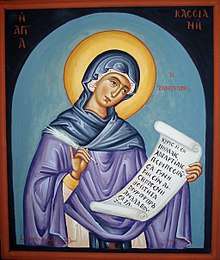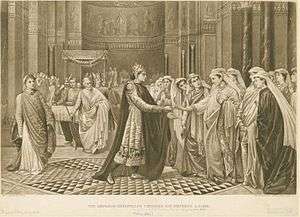Kassia
Kassia or Kassiani (Greek: Κασσιανή, romanized: Kassianí, pronounced [kasia'ni]; 805/810 - before 865) was a Byzantine abbess, poet, composer, and hymnographer. She is one of the first medieval composers whose scores are both extant and able to be interpreted by modern scholars and musicians. Approximately fifty of her hymns are extant and twenty-three are included in Orthodox Church liturgical books. The exact number is difficult to assess, as many hymns are ascribed to different authors in different manuscripts and are often identified as anonymous.
Saint Kassia | |
|---|---|
 Icon of St. Kassia | |
| Born | 810 Constantinople |
| Died | 865 Kasos |
| Venerated in | Latin Catholic Church Eastern Catholic Churches Eastern Orthodox Church |
| Canonized | Pre-congregation |
| Feast | 7 September |
Additionally, some 789 of her non-liturgical verses survive. Many are epigrams or aphorisms called "gnomic verse", for example, "I hate the rich man moaning as if he were poor."
Kassia is notable as one of at least two women in the middle Byzantine period known to have written in their own names, the other being Anna Comnena.[1]
Name
Her name is a feminine Greek form of the Latin name Cassius. It is variously spelled Κασσιανή (contemporary pronunciation [kaˈsçani]), Κασ(σ)ία (Kas[s]ia), Εικασία (Eikasia), Ικασία (Ikasia), Kassiani, Cas[s]ia, Cassiane, Kassiana. Modern English-language references to her as a composer generally use the name "Kassia," while references to her religious life tend to use Kassia or Kassiani.
Life

Kassia was born between 805 and 810 in Constantinople into a wealthy family[2] and grew to be exceptionally beautiful and intelligent. Three Byzantine chroniclers, Pseudo-Symeon the Logothete, George the Monk (a.k.a. George the Sinner) and Leo the Grammarian, claim that she was a participant in the "bride show" (the means by which Byzantine princes/emperors sometimes chose a bride, by giving a golden apple to his choice) organized for the young bachelor Theophilos by his stepmother, the Empress Dowager Euphrosyne. Smitten by Kassia's beauty, the young emperor approached her and said: "Through a woman [came forth] the baser [things]", referring to the sin and suffering coming as a result of Eve's transgression. Kassia promptly responded by saying: "And through a woman [came forth] the better [things]", referring to the hope of salvation resulting from the Incarnation of Christ through the Virgin Mary. According to tradition, the verbatim dialogue was:
"-Ἐκ γυναικὸς τὰ χείρω." Medieval Greek: [ek ʝyne'kos ta 'çiro]
"-Kαὶ ἐκ γυναικὸς τὰ κρείττω." Medieval Greek: [c(e) ek ʝyneˈkos ta ˈkrito]
His pride wounded by Kassia's terse rebuttal, Theophilos rejected her and chose Theodora as his wife.
When next we hear of Kassia in 843 she had founded a convent in the west of Constantinople, near the Constantinian Walls, and became its first abbess.[3] Although many scholars attribute this to bitterness at having failed to marry Theophilos and become Empress, a letter from Theodore the Studite indicates that she had other motivations for wanting a monastic life. It had a close relationship with the nearby monastery of Stoudios, which was to play a central role in re-editing the Byzantine liturgical books in the 9th and 10th centuries, thus ensuring the survival of her work (Kurt Sherry, p. 56). However, since the monastic life was a common vocation in her day, religious zeal is as likely a motive as either depression or aspiration for artistic renown.[4]
The Emperor Theophilos was a fierce iconoclast, and any residual feelings he may have had for Kassia did not preserve her from the imperial policy of persecution for her defence of the veneration of icons. Among other things, she was subjected to scourging with a lash. In spite of this, she remained outspoken in defence of the Orthodox Faith, at one point saying, "I hate silence, when it is time to speak."[4]
After the death of Theophilos in 842 his young son Michael III became Eastern Roman Emperor, with the Empress Theodora acting as Regent. Together they ended the second iconoclastic period (814-842); peace was restored to the empire.
Kassia traveled to Italy briefly, but eventually settled on the Greek Island of Kasos where she died sometime between 867 and 890 CE. In the city of Panaghia, there is a church where Kassia's tomb/reliquary may be found [5]
Works
Kassiani wrote many hymns which are still used in the Byzantine liturgy to this day. Kassiani became known to the great Theodore the Studite, while she was still a young girl, and he was impressed by her learning and literary style.[4] She not only wrote spiritual poetry, but composed music to accompany it. She is regarded as an "exceptional and rare phenomenon" among composers of her day[6] At least twenty-three genuine hymns are ascribed to her.[4]
Hymn of Kassia
The most famous of her compositions is the eponymous Hymn of Kassia (also known as the Troparion of Kassiani), which is chanted each year at matins on Holy Wednesday (which in usual parish practice is sung Tuesday evening) at the end of the aposticha.
Tradition says that in his later years the Emperor Theophilus, still in love with her, wished to see her one more time before he died, so he rode to the monastery where she resided. Kassia was alone in her cell, writing her Hymn when she realized that the commotion she heard was because the imperial retinue had arrived. She was still in love with him but was now devoted to God and hid away because she did not want to let her old passion overcome her monastic vow. She left the unfinished hymn on the table. Theophilus found her cell and entered it alone. He looked for her but she was not there; she was hiding in a closet, watching him. Theophilus, overcome with sadness, cried and regretted that moment of pride when he rejected such a beautiful and intellectual woman; then he noticed the papers on the table and read them. When he had finished reading, he sat and added one line to the hymn; then he left. The line attributed to the Emperor is the line "those feet whose sound Eve heard at dusk in Paradise and hid herself for fear". Legend says that as he was leaving he noticed Kassia in the closet but did not speak to her, out of respect for her wished privacy. Kassia emerged when the emperor was gone, read what he had written and finished the hymn.
The music for the hymn is slow, sorrowful and plaintive, lasting about ten to twenty minutes, depending on tempo and style of execution. It requires a very wide vocal range, and is considered one of the most demanding, if not the most demanding, pieces of solo Byzantine chant, and cantors take great pride in delivering it well. It is also sung by choirs in unison, often underpinned by Byzantine vocal bass drone. The faithful make a point of going to church specifically "to listen to Kassiani" that evening. In many places in Greece, the Bridegroom Matins service of Great Tuesday is popular with sex workers, who may not often be seen in church at other times of the year. They come in great numbers, in order to hear the Hymn of Kassiani, as the hymn is associated with the woman fallen in many sins.[7]
Portrayals
Many fictitious stories were created around her relationship with Emperor Theofilos. Contemporary historians such as Glykas, Ptochoprodromos, Kodinos, Zonaras and Georgios Amartolos described her exile in Italy during the Iconoclasy wars and later settled and died in Kasos sometime between 867 and 890 CE.
She is portrayed by Karima McAdams in the 5th season of the television series Vikings.
In August of 2019, English singer-songwriter Frank Turner included a song told from her point of view on his album No Man's Land.
Other works
Among the other hymns she composed are the following:
- The Doxastichon chanted at the Vesperal Divine Liturgy on Christmas Eve
- Numerous hymns in honor of saints found in the Menaion (fixed cycle of the Eastern Orthodox liturgical calendar), such as Feast of the Nativity of the Forerunner, 24 June.
- Among her hymns in the Triodion (liturgical book used during Great Lent) are the irmoi for the Matins Canon of Great Thursday.
- Her longest composition is a Canon for the Departed, consisting of 32 strophes, to be chanted at a Parastas (memorial services).
Religious commemoration
The feast day of Saint Kassiani is celebrated by the Orthodox Church on September 7.
She is often depicted on the icon of the Sunday of Orthodoxy (the First Sunday of Great Lent), because of her strong defence of the veneration of icons.
Recordings
The following are commercial recordings of the music of Kassia:
- Kronos Quartet: Early Music (Lachrymæ Antiquæ), USA 1997. Includes an instrumental arrangement of Kassia's "Using the Apostate Tyrant as His Tool".
- Sarband : Sacred Women, Women as Composers and Performers of Medieval Chant. Dorian, USA 2001. Album contains one piece by Kassia, Augustus-Sticheron Idiomelon Doxastikon: Vespers of December 25 (Athens MS 883) which is also recorded on the album by VocaMe.
- Deborah Kayser & Nick Tsiavos The Fallen Woman CD released 2008. Includes a recording of the Kassia Hymn. For further information please see http://nicktsiavos.net/ A recent performance of the Kassia Hymn by this duo has been uploaded to YouTube. See https://www.youtube.com/user/dimitrikyriakou Parts 4 & 5 of 7
- VocaMe : Kassia - Byzantine hymns of the first woman composer. Christophorus, Germany 2009. 18 tracks, with full sung texts in Greek script, German and English translations.[8]
- Choral Settings of Kassiani: with members of Cappella Romana and the English Chamber Choir. Various recordings of the Troparion of Kassiani and When Augustus Reigned. Released in 2011.
See also
References
- Stephenson, Paul, ed. (2010). The Byzantine World. p. 66. Retrieved 5 February 2013.
- Touliatos, Grove online
- "Other Women's Voices" Archived 2007-10-11 at the Wayback Machine
- The Lives of the Spiritual Mothers, Buena Vista CO: Holy Apostles Convent, 1991, pp. 374–381, ISBN 0-944359-05-1, LOC 91-070245
- Sanidopoulos, John. "The Tomb of Saint Kassiani in Kasos". Archived from the original on 2019-08-28. Retrieved 2019-09-17.
- Savas J. Svas, Hymnology of the Eastern Orthodox Church (Byzantine Melodies, 1983), p. 108.
- "Hymn Of Saint Kassiani". www.goarch.org. Greek Orthodox Archdiocese of America.
- Byzantine hymns of the first female composer: Kassia, vocame.de
Other sources
- Diane Touliatos. "Kassia", Grove Music Online, ed. L. Macy (accessed February 12, 2006), grovemusic.com (subscription access).
- Anna M. Silvas, "Kassia the Nun," in Lynda Garland (ed) Byzantine Women: Varieties of Experience 800-1200, Ashgate, 2006.
- Татьяна А. Сенина (монахиня Кассия). "Диалог Феофила и Кассии: литературная выдумка или реальность?" {Tatiana A. Senina (Nun Kassia), "Dialogue between Theophilus and Kassia: literary fiction or reality?"}, Scrinium. Т. 2: Universum Hagiographicum. Memorial R. P. Michel van Esbroeck, s. j. (1934–2003) / Ed. par B. Lourie et A. Mouraviev (Санкт-Петербург, 2006) 240–272
- Tatiana A. Senina (moniale Kassia), Ἡ γυνή φιλόσοφος: S. Cassia de Constantinople et Platon, Scrinium. Т. 4: Patrologia Pacifica and Other Patristic Studies / Ed. par B. Lourié et V. Baranov (St. Petersbourg, 2008) 333–340.
- Tatiana A. Senina (moniale Kassia). Rémarques sur le Canon des défunts écrit par S. Cassia de Constantinople, Scrinium. Т. 5: Symbola Caelestis. Le symbolisme liturgique et paraliturgique dans le monde chrétien / Éd. par A. Orlov et B. Lourié (2009) 317–322.
- Hagiography of St. Kassia from the Antiochian Orthodox Church
- Kosta Simić, "Life According to Nature: Ascetic Ideals in a Sticheron by Kassia", Crkvene studije / Church Studies 6, The Centre of Church Studies, Niš 2009, pp. 111–121. (https://www.academia.edu/1074079)
- Kassia the Nun in Context by Kurt Sherry
- Kosta Simić, “Kassia’s Hymnography in the Light of Patristic Sources and Earlier Hymnographical Works”, Zbornik Radova Vizantološkog Instituta 48 (2011) 7-37.
External links
- Works by Kassia at LibriVox (public domain audiobooks)
